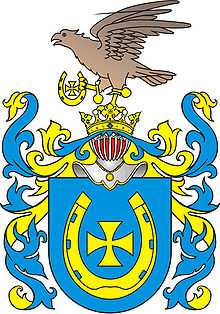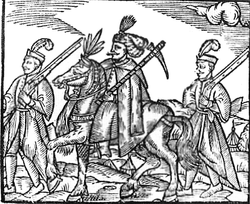Bartosz Paprocki
Bartholomew Paprocki (Polish: Bartłomiej Paprocki) (Czech: Bartoloměj Paprocký z Hlahol a Paprocké Vůle) (1543–1614) was a Polish and Czech writer, historiographer, translator, poet, herald and pioneer in the Polish and Czech genealogy.
Biography
He was born in Dobrzyń Lands town—Paprocka Wola in 1543, son of Jędrzej Paprocki and Elżbieta from Jeżewski. Paprocki was a Polish noble clan and they bore Jastrzębiec coat of arms. Bartosz studied at the Jagiellonian University. He began writing poems, but then dedicated himself to historiography and heraldry. In 1577, he participated in the Siege of Gdańsk. He was Podczaszy of Dobrzyń. In XVIc. `80s, he joined the pro—Habsburg party and supported Maximilian II, Holy Roman Emperor in the 1587 royal election, although he could have been bribed.[1] After the Battle of Byczyna in 1588, when Archduke Maximilian was defeated by the supporters of Sigismund III Vasa under leadership of Jan Zamoyski, Paprocki was made to abandon Poland and settle in Bohemia. There he spent 22 years, learned the Czech language and wrote about the history and heraldry of Bohemia and Moravia. He also translated Jan Kochanowski poems into Czech and wrote some for his own.[2] Later received Bohemian indigenate (noble citizenship). He was admirer of Michał Sędziwój (Michael Sendivogius) scientific achievements, whom he dedicated the third part of "Ogród królewski..." published in 1599.[2]
His wife was much older, but rich. Jadwiga Kosobudzka (died about 1572) a castellan's daughter from Sierpc, a widow of Wisniowski. They had no children and their marriage was unfortunate, Paprocki was tyrannized by his wife. Because of this experience, Paprocki remained misogynist till his death.[3] In 1610, Paprocki came back to Poland, lived in Wąchock and Ląd monasteries. Paprocki died on December 27, 1614 and was buried at Franciscan abbey in the city of Lviv. He was called the father of Polish and Czech genealogy
Bibliography
- "Gniazdo Cnoty, zkąd herby Rycerstwa Polskiego swój początek mają" 1578. Kraków
-(Family Virtues, from which the seals of Polish knights began)
- "Krótki a prawdziwy wypis z jechania do ziemi Wołoskiej Iwana Wojewody, którego Podkową zowią" 1578.Kraków
-(Short but True Excerpt in Coming of Iwan Wojewoda into the Land of Wallachia, Whom They Call "Horse Shoe")
- "Hetman" 1578
- "Wesele Bogiń" 1581.
-(Goddes wedding)
- "Herby Rycerstwa Polskiego, Na pięcioro Xiąg rozdzielone" 1584. Kraków
-(The heraldic arms of the Polish Knighthood)
-(Two of Bartosz Paprocki political pamphlets from 1587 and 1588 year)
- "Zrcadlo slavného Markrabí moravského" 1593.
-(Mirror of a Famous Moravian margraviate)
- "Ogród królewski w którym krótko opisuje historye Cesarzów, Królow Polskich i Czeskich, arcyksiążąt Austryi, książąt Ruskich" 1599. Praha
-(Royal garden, in Which I Write Briefly About the History of Emperors, Polish and Czech Kings, Austrian Archdukes and Russian Dukes)
- "Nauka Rozmaitych Philozophow, około obierania żony..." 1602. Kraków
-(The lesson of different philosophers about wife choosing...)
- "Diadochus, tj. posloupnost knížat a králů českých, biskupů a arcibiskupů pražských a všech třech stavů slavného království českého, to jest panského, rytířského a městského" 1602.
-(Diadochus, that`s, Hierarchy of Czech Princes and Kings, Bishops and Prague Archbishops and All Three Estates of the Famous Czech Kingdom, that`s, the Lords, Knights and Burghers)
- "Štambuch slezský" 1609.
-(Silesian friendship album alba amicorum)
-(Knights gathering)
-(Lesson and a warning for different human cases...)
- "O valce Turecké a jiné Přibéhy: vybor z Diadochu"
- "Panna, zenitba, zena ve staroceskie uprave polskych skladeb Reje z Naglovic"
See also
External links
References
|

